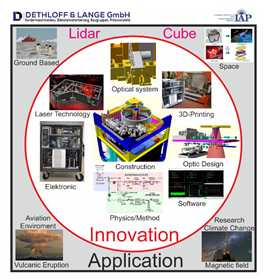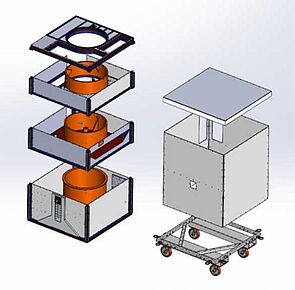RUBIN
“Regional entrepreneur alliances for innovation" (RUBIN) is a program of the Federal Ministry of Education and Research (BMBF) that envisages the transfer of innovations in structurally weak regions across Germany. RUBIN will strengthen the strategic collaborations between companies and their cooperation with universities and research institutes. Key is the transfer of research and development results into market-relevant products and services. The alliances develop, within a well-defined subject, innovations with a high potential for applications. This is an essential building block for sustainable profile formation within the region.
Alliance partners
1 LiCuSpace GmbH (Neubukow)
2 Leibniz-Institut für Atmosphärenphysik (Kühlungsborn)
3 SSN GmbH (Neubukow)
4 Fraunhofer-Institut für Lasertechnik ILT (Aachen)
5 Ickert - Elektronik (Warin)
6 BFPI Büro für praktische Informatik GmbH (Satow)
7 Silicann Systems GmbH (Rostock)
8 meteoSKY (Kühlungsborn)
9 AdvInno GmbH (Lübeck)
Concept phase
Funded by the BMBF (Federal Ministry of Education and Research)
Time period: 01/09/2021-28/03/2022


Implementation phase
Funded by the BMBF (Federal Ministry of Education and Research)
Time period: 01/04/2023-31/03/2027 (if the concept is approved by the BMBF)
IAP´s tasks
- during the concept phase
- Formulation of a implementation plan
- Adjustment of the implementation plan with the alliance partners
- during the implementation phase
- scientific research areas of the LIDAR Cube
- Application-related research
- LIDAR operations
- HMI operations
- Measurement methods
- Libraries
- HMI measurements
- Optics
- Laser eco system
- IP generation
Background information about LIDAR technology
LIDAR technology is an established measurement method for the exploration of the atmosphere (up to 100 km altitude).
By means of precise spectral measurements of Doppler-Rayleigh, Doppler-Mie, and Doppler resonance scattering temperatures, wind velocities, particle concentrations, and molecular abundances can be analyzed. In addition, different for the atmospheric understanding relevant parameters can be determined (e.g. aerosols). LIDAR diagnostic is a fundamental method for the observation and understanding of the atmosphere and the proceeding climate change.
Common LIDAR measurements require large technological efforts related to infrastructure and resources. LIDAR cubes enable locally and temporally flexible operations to analyze current atmospheric and climate-related scientific questions.












